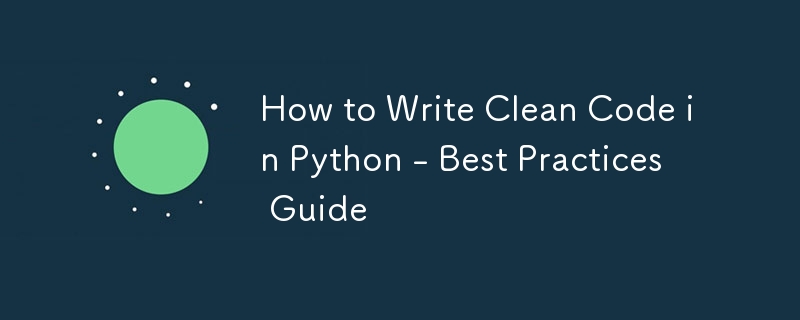

When writing Python code, it's essential to make it clean and easy to read. Clean code means your code is well-organized, simple to understand, and easy to maintain. In this guide, we’ll share the best tips to help you write clean code in Python, whether you're a beginner or an experienced developer.
Writing clean code is essential for many reasons:
One of the easiest ways to improve code readability is by using clear and meaningful names for variables and functions. Avoid single-letter or cryptic names like x, y, or foo.
Example:
# Bad example
def calc(x, y):
return x + y
# Good example
def calculate_total_price(item_price, tax):
return item_price + tax
In the second example, it's easy to understand what the function does just by looking at the function name and variable names.
PEP 8 is Python's official style guide, providing conventions for writing clean and readable code. Some key PEP 8 recommendations include:
Example:
# PEP 8 Example
def calculate_discounted_price(price, discount):
"""Calculate the final price after applying the discount."""
discounted_amount = price * (discount / 100)
final_price = price - discounted_amount
return final_price
Break your code into smaller, manageable functions. Each function should do one specific task, making it easier to read, test, and debug.
Example:
# Bad example
def process_order(customer, items):
total_price = 0
for item in items:
total_price += item['price']
if total_price > 100:
discount = total_price * 0.1
total_price -= discount
# Send email
print(f"Order confirmed for {customer['name']}")
return total_price
# Good example
def calculate_total_price(items):
return sum(item['price'] for item in items)
def apply_discount(total_price):
if total_price > 100:
return total_price * 0.9
return total_price
def send_confirmation_email(customer):
print(f"Order confirmed for {customer['name']}")
def process_order(customer, items):
total_price = calculate_total_price(items)
total_price = apply_discount(total_price)
send_confirmation_email(customer)
return total_price
In the improved example, the code is split into smaller functions, making it easier to understand and maintain.
List comprehensions in Python provide a concise way to create lists. Using them can make your code cleaner and more readable.
Example:
# Without list comprehension
squares = []
for x in range(10):
squares.append(x ** 2)
# With list comprehension
squares = [x ** 2 for x in range(10)]
The second example is shorter and easier to read.
Avoid hardcoding values directly in your code. Instead, use constants or configuration files. This makes your code more flexible and easier to update.
Example:
# Bad example
def calculate_discount(price):
return price * 0.1 # Discount is hardcoded
# Good example
DISCOUNT_RATE = 0.1
def calculate_discount(price):
return price * DISCOUNT_RATE
In the second example, the discount rate is stored in a constant, making it easier to change if needed.
While clean code should be self-explanatory, adding comments and docstrings can help explain the purpose of complex functions or algorithms.
def find_largest_number(numbers):
"""
Find the largest number in a list.
Args:
numbers (list): A list of numbers.
Returns:
int: The largest number.
"""
return max(numbers)
The docstring helps other developers understand how to use the function without needing to read the entire code.
Avoid duplicating code. If you notice repeating patterns, try to refactor your code to reuse functions or classes. This will make your code more maintainable and reduce the chances of errors.
Example:
# Bad example
def get_full_name1(first_name, last_name):
return first_name + " " + last_name
def get_full_name2(first_name, last_name):
return first_name + " " + last_name
# Good example
def get_full_name(first_name, last_name):
return first_name + " " + last_name
Always handle exceptions using try and except blocks to prevent your program from crashing. You should also provide informative error messages to make debugging easier.
Example:
# Bad example
def divide_numbers(a, b):
return a / b
# Good example
def divide_numbers(a, b):
try:
return a / b
except ZeroDivisionError:
return "Error: Cannot divide by zero"
The second example prevents a crash and provides a helpful error message.
Python 3.6 introduced f-strings, a simple and readable way to format strings. They are much cleaner than older string formatting methods.
Example:
# Old way
name = "Alice"
greeting = "Hello, %s!" % name
# With f-strings
greeting = f"Hello, {name}!"
F-strings make your code easier to read and maintain.
Only import the necessary modules and functions. Avoid wildcard imports like from module import * as they can clutter the namespace and make it harder to track dependencies.
Example:
# Bad example from math import * # Good example from math import sqrt, pi
Writing clean code in Python is a valuable skill that helps you create readable, maintainable, and bug-free software. By following the best practices outlined in this guide—using meaningful names, following PEP 8, keeping your code modular, and handling errors gracefully—you can significantly improve your coding style.
Focus on readability, simplicity, and consistency, and you'll be well on your way to writing clean, professional Python code.
The above is the detailed content of How to Write Clean Code in Python - Best Practices Guide. For more information, please follow other related articles on the PHP Chinese website!
 How to make charts and data analysis charts in PPT
How to make charts and data analysis charts in PPT
 Android voice playback function implementation method
Android voice playback function implementation method
 AC contactor use
AC contactor use
 The difference between vscode and visual studio
The difference between vscode and visual studio
 The difference between Java and Java
The difference between Java and Java
 Introduction to hard disk interface types
Introduction to hard disk interface types
 nagios configuration method
nagios configuration method
 How to delete a folder in linux
How to delete a folder in linux




